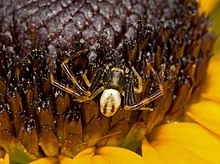Mutable crab spider
| Mutable crab spider | ||||||||||||
|---|---|---|---|---|---|---|---|---|---|---|---|---|

Mutable Crab Spider ( Misumena vatia ), female |
||||||||||||
| Systematics | ||||||||||||
|
||||||||||||
| Scientific name | ||||||||||||
| Misumena vatia | ||||||||||||
| ( Clerck , 1757) |
The mutable crab spider ( Misumena vatia ) is a species of spider from the family of crab spiders (Thomisidae). The species is widespread in Central Europe. The mutable crab spider was voted Spider of the Year 2006.
features
The species shows a strong sexual dimorphism in terms of size and color. Males only reach a body length of 4 mm, while the females are up to 10 mm long. The male has a blackish front body ( prosoma ); the back of the body ( opisthosoma ) is white to yellowish in color and shows two dark longitudinal stripes. The two front pairs of legs are broadly banded with black and brown, the two rear pairs of legs show the basic color of the opisthosoma.
In females, the color of the entire body varies between bright yellow, yellow-green and white. They can actively change their body color for camouflage. The sides of the back of the body often have two red vertical stripes.
distribution and habitat
The species inhabits the arctic to subtropical zones of the Holarctic from Ireland and Portugal to Japan and America from Alaska to the southern border of the USA . With the exception of Iceland, it occurs throughout Europe. The finds so far for Germany indicate an almost area-wide distribution in the southern and central part of the country, while the species is found much less frequently north of the low mountain ranges.
The species inhabits open, blooming habitats of all kinds. Adults can be found from May to July.
nutrition
The mutable crab spider hangs on flowers to catch prey. She is able to adapt the body color to the respective flower color. However, only adult females are capable of this color change. The color change is controlled by the sense of sight. A yellow color is a liquid, yellow dye stored in the epidermal cells , while the white color is due to the shifting of the pigment inside the body. The yellow dye can also be partially excreted with the faeces if the flowers stay for a long time .
Misumena vatia prey consists of all kinds of flower-visiting insects, e.g. B. hoverflies , bees , wasps , butterflies or smaller beetles . These are often several times larger than the spider. This seizes its prey with lightning speed with the two strong and greatly enlarged pairs of forelegs and usually kills it with an apparently very fast-acting bite in the rear neck.
Reproduction
Mating takes place in early summer. When a male has found a female, it climbs from the front onto its back. For copulation, it climbs over the rear end of the female on its belly side and alternately introduces its pedipalps into the sexual opening of the female in a belly-to-belly position . It then climbs back onto the female's back and then copulates again after a pause. Eventually the male leaves the female. To plant the egg cocoon, hiding places away from the flowers are evidently sought out. The young spiders overwinter on the ground.
Danger
The species is widespread and medium abundant in suitable habitats. In Germany it is classified as "safe" in the Red List .
swell
literature
- Heiko Bellmann : Cosmos Atlas Arachnids of Europe . 3rd edition, 2006. Kosmos, Stuttgart. ISBN 978-3-440-10746-1
- Ralph Platen, Bodo von Broen, Andreas Herrmann, Ulrich M. Ratschker & Peter Sacher: Total species list and red list of spiders, harvestmen and pseudoscorpions of the state of Brandenburg (Arachnida: Araneae, Opiliones, Pseudoscorpiones) with information on frequency and ecology. Nature conservation and landscape management in Brandenburg 8, booklet 2 (supplement); 1999.
Individual evidence
- ^ Map on the worldwide distribution of the variable crab spider from the British Arachnological Society
- ^ Atlas of the arachnids of Europe: evidence of Misumena vatia





